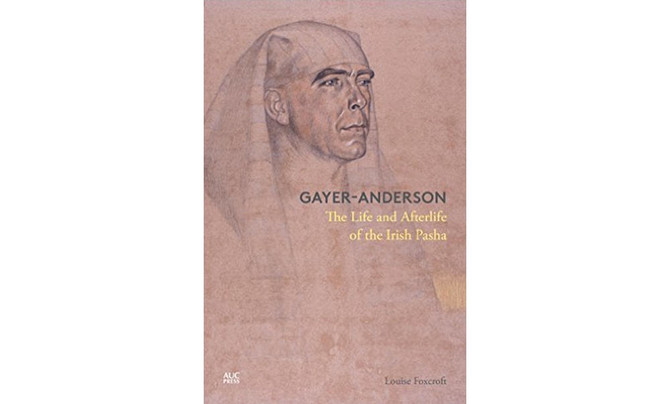Major Robert Grenville Gayer-Anderson has given his name to one of the most enjoyable cultural outings in Cairo, a visit to the Bait Al-Kretliya, which consists of two beautifully restored old Islamic houses joined together by a bridge, popularly known as the Gayer-Anderson Museum.
For the first time a biography, “Gayer-Anderson: The Life and Afterlife of the Irish Pasha” explores the fascinating life of a man who was a colonial government representative and also received the title of Pasha by King Farouk. Known also as John, and P.U.M. (a mysterious acronymic nickname that his identical twin brother Thomas gave him), Robert Grenville Gayer-Anderson studied to be a surgeon, but he was also a soldier, an adventurer, an enthusiastic collector of antiquities and a passionate Egyptologist. In this intimate portrait of a multifaceted and enigmatic figure Louise Foxcroft attempts to reveal the person behind the persona.
Gayer-Anderson is mostly remembered for acquiring a most remarkable collection of antiquities, mostly from ancient Egypt. He had always expressed his wish to visit an empty tomb. This rare privilege finally took place in 1923, a year marked by an extraordinary event, the discovery of Tutankhamun’s Tomb by Howard Carter. Gayer-Anderson was at the time posted in Egypt as assistant Oriental secretary. He was, therefore, a member of the official party invited at the private opening of the tomb of Tutankhamun.
When Gayer-Anderson entered the tomb, he immediately noticed the charming models of ships, baby chairs and chariots. The following day, he mentioned in a letter that he believed Tutankhamun was a youth about 17 or 18 years old. An X-ray examination proved that he was right: Tutankhamun was just under the age of 18 when he died. At the end of the visit, Gayer-Anderson decided that he had not seen enough and he made up his mind to return for another visit to the tomb with his mother.
Gayer-Anderson was very close to his mother, Mary. In an unpublished memoir, “Fateful Attractions,” on which this book is based, Gayer-Anderson acknowledges that he inherited from her a profound love of beauty, which he compared to the “bread of life.” His father, Henri Anderson had a violent and cruel nature. He submitted his child to a Spartan upbringing, which was deeply resented by young Pum and his siblings. Placed in a row in front of their father, the children were subjected to painful things. “He would give a sudden shout, quickly raise a threatening hand, tickle our ribs, pinch us or pull our hair… in spite of which none of us must show the slightest emotion of any sort. If we flinched, flushed, giggled, gasped, laughed or even flickered an eyelid we were shouted at and slapped,” writes Gayer-Anderson.
Henri Anderson played these mean and nasty games during their last year in North America. During their harrowing stay, Henri Anderson managed to make some money in real estate and a very young Pum developed his passion for collecting. He found some lead bullets and chipped flint arrowheads.
During his life, Gayer-Anderson had the knack to find exceptional pieces. He has a remarkable flair for discovering precious antiquities. One of his first important finds was an unusual bone, which he discovered during a walk over the Medway after the family had returned to the United Kingdom. He showed it to his form-master who suggested that he send it to the Royal Geological Society. The bone was a humerus, which turned out to be part of an unknown type of pterodactyl, or “flying dragon.” This fossil was the first in a long list of gifts that Gayer-Anderson gave to museums.
Henri Anderson decided that his son should become a doctor like his two uncles. At the age of 17, he started training at Guy’s Hospital in London and qualified five years later as Member of the Royal College of Surgeons and Licentiate of the Royal College of Physicians.
During that time, he also found a man’s portrait in oils on a broken panel that he bought for a shilling. With his usual flair, Gayer-Anderson had noticed the signature of Van Dyck at the back. It was later confirmed by experts as authentic. Gayer-Anderson had become more than ever addicted to collecting. “It became both a vice and a mania,” he wrote.
When he finished his medical studies, Gayer-Anderson was appointed assistant house surgeon to William Arbuthnot-Lane. He had been encouraged to aim for a Harley Street career but that was not the life he wished to lead. He was looking for something else, something more adventurous. He was just 23 years old, young and restless, so he decided to follow his twin brother and join the Royal Army Medical Corps. In 1907, he was posted to Egypt with the rank of major.
“Pum’s lifelong affair with Egypt, its culture, and its people had begun” writes Foxcroft.
On a trip to Khartoum where he was replacing a local surgeon who had been taken ill, Gayer-Anderson bought a beautiful bronze Horus from a wealthy dealer. In time, he realized that he should be more careful and buy only from “less known and less-knowing” dealers, men who knew little and lacked the expertise so that one could buy rare antiquities for very little money.
After two years, Gayer-Anderson returned home for a holiday. As he was sailing back to England, he realized how much he had changed. He was no longer interested in medicine, and he desperately wanted to return to Egypt. At the end of 1909, he was posted back to Egypt as inspector of recruiting for the Sa’id, the seven provinces of Upper Egypt.
As he traveled along the Nile several times a year, he got to know local traders who would run after him as soon as they spotted his boat. Gayer-Anderson was doing an astonishing amount of dealing and collecting. In fact, collecting became his main occupation to the detriment of his service ambitions. Egypt was a cradle of civilization and Cairo was a center for Middle Eastern and Far Eastern art including India, China and Persia. Gayer-Anderson was particularly fond of Fayoum. Fayoum is the largest oasis in Egypt and the closest to the Nile and Cairo. It has a host of archaeological sites from the Middle Kingdom when Fayoum was a center of political power. Gayer-Anderson wrote in his memoires that Fayoum was the “most exciting and fascinating place I know from a historical and antique-collecting point of view. Nowhere in the world can one see history and pre-history more abundantly and consecutively written.”
He could find in Fayoum a pre-dynastic vessel, an early dynasty stone-relief, Ptolemaic statues, Greek terracotta figurines or Roman glass bottles, the choice of objects was endless and the price was very low.
Gayer-Anderson was becoming an expert in ancient Egyptian and Saracen antiquities. “He bought from the shopkeepers or from the original finders, the sebakheen, who had an ancient and legal right dating from the days of the Turkish suzerainty to sift the sebakb, the dust and debris from a site. And from these families he got the rarest pieces for a fraction of their final value. In this way, he amassed large collections of all sorts. He sold some of them, making himself good money but he also bought for many of the larger museums in the United Kingdom, Sweden, and America,” writes Foxcroft.
Gayer-Anderson now in his early 30s had amassed a certain wealth and yearned to live the life that really pleased him. However, he would still have to wait a few more years. He had enjoyed “supreme happiness” during the first decade of the 20th century unaware that the world was “on the brink of a volcano.” During World War I, he was posted in Egypt and in Gallipoli on the Turkish coast. He ended his official career in Egypt with a post of senior inspector in the Ministry of Interior and was finally appointed Oriental secretary to the high commissioner where he remained for about a year. He retired from the Egyptian government in 1923. He was only 42 and he wanted to spend the rest of his life with his antiques and writing poems and articles for magazines.
In the 1930s, he was offered a job as director of the Anglo-American Nile Tourist Company, which gave him the possibility to continue searching for antiques. During that period he purchased one of his most precious pieces known as the Gayer-Anderson Cat, the first life-size bronze cat he had ever seen. He would eventually bequeath it to the British Museum. His last philanthropic action was the internal renovation of the Bait Al-Kretliya.
He was allowed to live in this old Islamic house during his lifetime in order to restore it. When he died, it was returned to the government as the “Gayer-Anderson Pasha Museum of Oriental Arts and Crafts.” The Bait Al-Kretliya has been magnificently restored. The Damascus room is stunning with its ceilings and walls covered in inlaid and gilded wood. A scene from a James Bond movie, “The Spy Who Loved Me,” was filmed in Bait Al-Kretliya. Gayer-Anderson also entertained many visitors including the King of Siam, Howard Carter and Freya Stark.
The eight years Gayer-Anderson spent at Bait Al-Kretliya were the happiest of his life. He would certainly be proud to see how his beloved home is one of the most visited museums in Cairo.
• [email protected]
A journey from abused child to Egyptian antiquities collector
A journey from abused child to Egyptian antiquities collector

What We Are Reading Today: Out of One, Many

Author: Jennifer T. Roberts
Covering the whole of the ancient Greek experience from its beginnings late in the third millennium BCE to the Roman conquest in 30 BCE, “Out of One, Many” is an accessible and lively introduction to the Greeks and their ways of living and thinking. In this fresh and witty exploration of the thought, culture, society, and history of the Greeks, Jennifer Roberts traces not only the common values that united them across the seas and the centuries, but also the enormous diversity in their ideas and beliefs.
Examining the huge importance to the Greeks of religion, mythology, the Homeric epics, tragic and comic drama, philosophy, and the city-state, the book offers shifting perspectives on an extraordinary and astonishingly creative people.
Century after century, in one medium after another, the Greeks addressed big questions, many of which are still very much with us, from whether gods exist and what happens after we die to what political system is best and how we can know what is real. Yet for all their virtues, Greek men set themselves apart from women and foreigners and profited from the unpaid labor of enslaved workers, and the book also looks at the mixed legacy of the ancient Greeks today.
The result is a rich, wide-ranging, and compelling history of a fascinating and profoundly influential culture in all its complexity—and the myriad ways, good and bad, it continues to shape us today.
What We Are Buying Today: ‘If Cats Disappeared from the World’

- Beautifully written and emotionally moving, it is also a testament to the power of storytelling and reminds people of the deep impact of making personal choices and connections
Author: Genki Kawamura
“If Cats Disappeared from the World” is a novel written by Japanese author Genki Kawamura. The book was published in 2012 and was rated 4/5 by over 75,000 readers worldwide.
Kawamura is a worldwide bestselling author. “If Cats Disappeared from the World” was his first novel, which sold over 1 million copies in Japan and was translated into over 14 languages.
In this novel, Kawamura tells the story of a postman who is diagnosed with an uncurable illness. However, when he accepts his destiny, the Devil appears to him with an unusual proposal. The postman must choose one thing to eliminate from this world for him to live one more day. During his journey, the postman then starts examining the true value of everything he owns.
Kawamura’s writing style is simple yet evocative, inviting readers to dive deep into the layers of their own emotional journey with every page. The narrative provides a delicate balance between moments of happiness and sorrow, using cats as a symbol of companionship and joy.
Moreover, the book allows readers to reflect on the value of relationships and experiences. It raises questions regarding the decisions people make, the legacies they leave behind, and the core meaning of everyday moments, which eventually shape people’s characters and how they think.
The novel encourages people to take a deep breath and reflect on the blessings people have, yet neglect, due to their busy lives.
With Kawamura’s thoughtful message and memorable characters, this novel is a compelling exploration of the human experience, providing comfort and inspiration, and a new appreciation for the beauty and brevity of life.
Beautifully written and emotionally moving, it is also a testament to the power of storytelling and reminds people of the deep impact of making personal choices and connections.
What We Are Reading Today: ‘Chinese Espresso’ by Grazia Ting Deng

Italians regard espresso as a quintessentially Italian cultural product—so much so that Italy has applied to add Italian espresso to UNESCO’s official list of intangible heritages of humanity. In this book, Grazia Ting Deng explores the paradox of “Chinese Espresso”— the fact that this most distinctive Italian social and cultural tradition is being preserved by Chinese immigrants and their racially diverse clientele.
What We Are Reading Today: ‘Bartleby and Me’

Writers love to write about writing and none seemingly more so than Gay Talese, the journalist known as a pioneer of the American literary moment called “New Journalism.” This style of writing originated in the 1960s and ‘70s and combines journalistic research with creative non-fiction.
Talese started his career as an obituary writer at the New York Times and, later, as a magazine writer who ended up reluctantly penning the most widely read magazine articles of all time. He showcases some of that editorial wisdom — and reporting mishaps — in his 2023 book, “Bartley and Me: Reflections of an Old Scrivener.”
Now 92 years old, he writes vividly about his early reporting days and the stories behind the stories; he masterfully weaves in stray strands that somehow come together into a coherent narrative. Talese writes crisp copy. He writes about nobodies and somebodies with equal fervor.
He recalls his time as a young reporter on assignment where, at the insistence of his persistent editor, he attempted to sit down for an interview with the elusive and super-famous star Frank Sinatra. Talese recounts how he repeatedly tried — and failed — to pin down “Ol’ Blue Eyes” while chasing him around California in the 1960s. He eventually published his distinctively titled profile, “Frank Sinatra Has a Cold,” in the April 1966 issue of Esquire. That piece of writing is considered one of the most celebrated pieces of magazine journalism to date.
Talese’s tales are mostly centered around his time in New York. He recalls things in meticulous detail — for example, pointing out the exact address and precise building within a neighborhood to help the reader visualize the space. The city is always a leading part of the story.
“New York is a city of things unnoticed,” he wrote 60 years ago, something that could easily be written today. He recalls the early days of his journalistic career in New York, churning out newspaper copy and still, now, being ever-so-curious about everything. The pages of this book show that we all, alongside him, still have much more to notice.
The title of the book was inspired by American author Herman Melville’s short story, “Bartleby, the Scrivener: A Story of Wall Street,” published in the 1800s. This is a social criticism piece about a lawyer who hires a peculiar scrivener or clerk, Bartleby, and the adventures (or misadventures) that ensue.
In his version, Talese shares with us a fresh piece of original reporting titled “Dr. Bartha’s Brownstone,” which is his version of “Bartleby.” This time, however, Bartleby is an unknown doctor who makes his bombastic mark on the city one random summer day. It is a brilliant piece of journalism about journalism.
What We Are Reading Today: ‘The Proof Stage’ by Stephen Abbott

The discovery of alternate geometries, paradoxes of the infinite, incompleteness, and chaos theory revealed that, despite its reputation for certainty, mathematical truth is not immutable, perfect, or even perfectible.
Beginning in the last century, a handful of adventurous playwrights took inspiration from the fractures of modern mathematics to expand their own artistic boundaries.
















